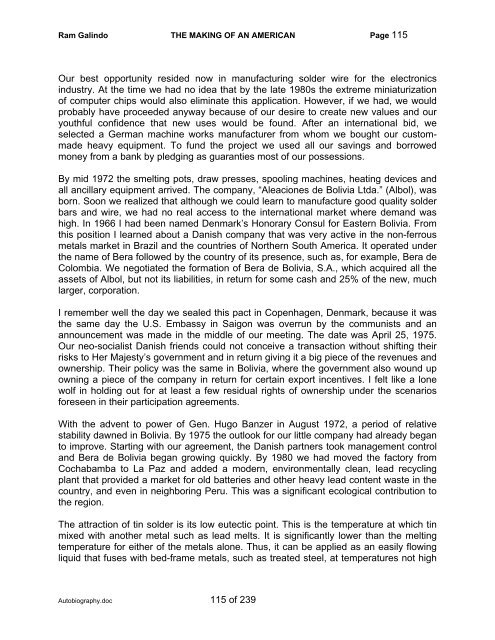Autobiography - The Galindo Group
Autobiography - The Galindo Group
Autobiography - The Galindo Group
Create successful ePaper yourself
Turn your PDF publications into a flip-book with our unique Google optimized e-Paper software.
Ram <strong>Galindo</strong> THE MAKING OF AN AMERICAN Page 115<br />
Our best opportunity resided now in manufacturing solder wire for the electronics<br />
industry. At the time we had no idea that by the late 1980s the extreme miniaturization<br />
of computer chips would also eliminate this application. However, if we had, we would<br />
probably have proceeded anyway because of our desire to create new values and our<br />
youthful confidence that new uses would be found. After an international bid, we<br />
selected a German machine works manufacturer from whom we bought our custommade<br />
heavy equipment. To fund the project we used all our savings and borrowed<br />
money from a bank by pledging as guaranties most of our possessions.<br />
By mid 1972 the smelting pots, draw presses, spooling machines, heating devices and<br />
all ancillary equipment arrived. <strong>The</strong> company, “Aleaciones de Bolivia Ltda.” (Albol), was<br />
born. Soon we realized that although we could learn to manufacture good quality solder<br />
bars and wire, we had no real access to the international market where demand was<br />
high. In 1966 I had been named Denmark’s Honorary Consul for Eastern Bolivia. From<br />
this position I learned about a Danish company that was very active in the non-ferrous<br />
metals market in Brazil and the countries of Northern South America. It operated under<br />
the name of Bera followed by the country of its presence, such as, for example, Bera de<br />
Colombia. We negotiated the formation of Bera de Bolivia, S.A., which acquired all the<br />
assets of Albol, but not its liabilities, in return for some cash and 25% of the new, much<br />
larger, corporation.<br />
I remember well the day we sealed this pact in Copenhagen, Denmark, because it was<br />
the same day the U.S. Embassy in Saigon was overrun by the communists and an<br />
announcement was made in the middle of our meeting. <strong>The</strong> date was April 25, 1975.<br />
Our neo-socialist Danish friends could not conceive a transaction without shifting their<br />
risks to Her Majesty’s government and in return giving it a big piece of the revenues and<br />
ownership. <strong>The</strong>ir policy was the same in Bolivia, where the government also wound up<br />
owning a piece of the company in return for certain export incentives. I felt like a lone<br />
wolf in holding out for at least a few residual rights of ownership under the scenarios<br />
foreseen in their participation agreements.<br />
With the advent to power of Gen. Hugo Banzer in August 1972, a period of relative<br />
stability dawned in Bolivia. By 1975 the outlook for our little company had already began<br />
to improve. Starting with our agreement, the Danish partners took management control<br />
and Bera de Bolivia began growing quickly. By 1980 we had moved the factory from<br />
Cochabamba to La Paz and added a modern, environmentally clean, lead recycling<br />
plant that provided a market for old batteries and other heavy lead content waste in the<br />
country, and even in neighboring Peru. This was a significant ecological contribution to<br />
the region.<br />
<strong>The</strong> attraction of tin solder is its low eutectic point. This is the temperature at which tin<br />
mixed with another metal such as lead melts. It is significantly lower than the melting<br />
temperature for either of the metals alone. Thus, it can be applied as an easily flowing<br />
liquid that fuses with bed-frame metals, such as treated steel, at temperatures not high<br />
<strong>Autobiography</strong>.doc 115 of 239


